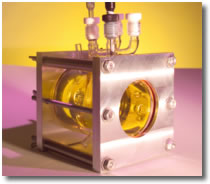
![]()
DOE Projects
A major component of FSEC’s research program has been its long-standing hydrogen and fuel cell R&D projects and activities that have been supported by the U.S. Department of Energy (DOE). The following projects are examples of DOE funded activities presently being conducted at FSEC.
Production of Hydrogen by Solar Thermochemical Water-Splitting Cycles – FSEC in a joint program with the Science Applications International Corporation of San Diego, CA was awarded a competitively procured project from DOE to develop a solar thermochemical process for the production of hydrogen from water. This is an R&D project leading to the demonstration of a cost-effective water-splitting cycle for hydrogen production using high-flux solar concentrators. Past research in solar thermochemical cycles has focused on two-step processes involving metal oxides that utilize only the thermal component of the solar spectrum. FSEC’s approach utilizes the high-energy photons available within the solar spectrum to stimulate the chemical reactions to split water more efficiently. The FSEC proposed cycle received the Innovative Technology Award at the 5th World Hydrogen Energy Conference in Yokohama , Japan – the only such award given to researchers from the U.S. A provisional patent on this process has been filed with the U.S. PTO on behalf of FSEC.
This DOE-funded project involves three phases. In Phase 1, FSEC will fine-tune its technology for solar thermochemical hydrogen production based on high-temperature water-splitting cycles. SAIC will work with FSEC to develop a preliminary design of the pilot-scale solar concentrator/solar receiver and perform the economic analysis. In Phase 2, the SAIC-FSEC team will build a 50-kW thermochemical reactor/solar receiver system for use with an SAIC dish connector. The Phase 3 work will demonstrate the 50-kW solar-powered hydrogen production unit in Tempe, Arizona.
This DOE-funded project involves three phases. In Phase 1, FSEC will fine-tune its technology for solar thermochemical hydrogen production based on high-temperature water-splitting cycles. SAIC will work with FSEC to develop a preliminary design of the pilot-scale solar concentrator/solar receiver and perform the economic analysis. In Phase 2, the SAIC-FSEC team will build a 50-kW thermochemical reactor/solar receiver system for use with an SAIC dish connector. The Phase 3 work will demonstrate the 50-kW solar-powered hydrogen production unit in Tempe, Arizona.
High Temperature, Low Relative Humidity Membrane Fuel Cell Program
FSEC’s fuel cell researchers are presently operating and managing the U.S. Department of Energy’s (DOE) $19 million High Temperature, Low Relative Humidity Membrane fuel cell program. DOE has funded 12 projects aimed at advancing membrane durability and extending shelf-life while bringing down the cell’s costs. As the program lead, FSEC is coordinating these projects and playing a key role in directing the efforts of the other participating universities in developing membranes that will allow hydrogen to create electricity to power vehicles.This program involves overseeing the activities of a High Temperature, Low Relative Humidity Membrane Working Group that includes researchers from the national laboratories, Arizona State University, Case Western Reserve University, Clemson University, Colorado School of Mines, FuelCell Energy, General Electric, Giner Electrochemical Systems, Pennsylvania State University, the University of Tennessee and Virginia Tech. The working group’s research agenda is to prepare and evaluate new membranes for proton exchange membrane (PEM) fuel cells.
For the DOE project, FSEC’s researchers team will prepare and evaluate new polymeric electrolyte phosphotungstic acid composite membranes to solve the temperature problem. FSEC researchers working with the fuel cell community will also develop standardized experimental methodologies to measure conductivity as a function of relative humidity and mechanical properties of membranes; characterize mechanical, mass transport and surface properties of the membranes, and predict durability of the membranes and their membrane electrode assemblies fabricated by the team for both the in-house research program and for membranes provided by the High Temperature, Low Relative Humidity Membrane Working Group members.
FSEC will also provide the working group with standardized tests and methodologies and short course education offerings on test methodologies along with membrane electrode assembly fabrication techniques so that at the end of three years all members of the Group will be able to perform this work in their own facility. An easily implemented protocol and rapid test apparatus for evaluating the through-thickness conductivity (or resistance) of membranes over a broad range of conditions will be developed.

